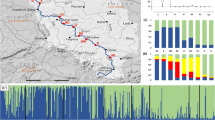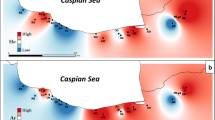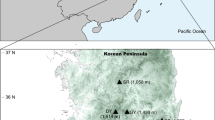Abstract
The European black poplar (Populus nigra L.) is a tree species that once had the central role in the development of riparian ecosystems in a great part of Europe and Asia. During centuries, it is harassed by the riverside’s urbanization, drainage of wetlands, and controlled river management, and compromised by intercrossing with other poplar species and cultivated hybrids. With the aim to perceive its genetic diversity and integrity along the Danube River, 12 natural P. nigra forests from corresponding protected areas were assessed using eight highly polymorphic microsatellite loci and win3 genetic marker. In the sample set, among individuals morphologically recognized as P. nigra, 2.28 % were identified as P. × euramericana hybrids and those were excluded from further analyses. High number of alleles and high heterozigosity have been observed in all populations. Only 2.95 % of total genetic variance was recorded among populations, while the pattern of genetic differentiation corresponds to the isolation by geographic distance. It was found that one population had experienced a recent reduction in population size. We infer that genetic integrity and variation of European black poplar is not compromised within the studied areas which are, therefore, able to provide high-quality genetic material of non-hybrid P. nigra for maintaining and promoting metapopulations along the Danube River.




Similar content being viewed by others
References
Anderson EC, Thompson EA (2002) A model-based method for identifying species hybrids using multilocus genetic data. Genetics 160:1217–1229
Arbez M, Lefèvre F (1997) Objectives and general concept. A case study concerning the black poplar. The European Forest Genetic Resource Programme, pp 389-398
Arens P, Coops H, Jansen J, Vosman B (1998) Molecular genetic analysis of black poplar (Populus nigra L.) along Dutch rivers. Mol Ecol 7:11–18. doi:10.1046/j.1365-94x.1998.00316.x
Bordács S, Popescu F, Slade D, Csaikl UM, Lesur I, Borovics A, Kézdy P, König AO, Gömöry D, Brewer S, Burg K, Petit RJ (2002a) Chloroplast DNA variation of white oaks in northern Balkans and in the Carpathian Basin. For Ecol Manag 156:197–209. doi:10.1016/S0378-1127(01)00643-0
Bordács S, Borovics A, Bach I (2002b) Genetic diversity of natural populations and gene bank of black poplar in Hungary. In: van Dam BC, Bordács S (eds) Genetic diversity in river populations of European black poplar: implications for riparian eco-system management. Proceedings of an International Symposium, Csiszár Nyomda, pp 93–106
Cagelli L, Lefèvre F (1995) The conservation of Populus nigra L. and gene flow with cultivated poplars in Europe. For Genet 2:135–144
Coaloa D, Nervo G. (2008) Poplar wood production in Europe on account of market criticalities and agricultural, forestry and energy policy. Tercer Congreso Internacional de Salicáceas en Argentina. http://www.populus.it/pdf/JS2011_COALOA_NERVO.PDF
Cornuet JM, Luikart G (1996) Description and power analysis of two tests for detecting recent population bottlenecks from allele frequency data. Genetics 144:2001–2014
Cottrell JE, Krystufek V, Tabbener HE, Milner AD, Connolly T, Sing L, Fluch S, Burg K, Lefèvre F, Achard P, Bordács S, Gebhardt K, Vornam B, Smulders MJM, Vanden Broeck AH, Van Slyken J, Storme V, Boerjan W, Castiglione S, Fossati T, Alba N, Agúndez D, Maestro C, Notivol E, Bovenschen J, Van Dam BC (2005) Postglacial migration of Populus nigra L.: lessons learnt from chloroplast DNA. For Ecol Manag 206:71–90. doi:10.1016/j.foreco.2004.10.052
Doyle JJ, Doyle JL (1990) Isolation of plant DNA from plant material. Focus 12:13–15
Earl DA, von Holdt BM (2012) STRUCTURE HARVESTER: a website and program for visualizing STRUCTURE output and implementing the Evanno method. Conserv Genet Resour 4:359–361. doi:10.1007/s12686-011-9548-7
England PR, Cornuet J-M, Berthier P, Tallmon DA, Luikart G (2006) Estimating effective population size from linkage disequilibrium: severe bias in small samples. Conserv Genet 7:303–308. doi:10.1007/s10592-005-9103-8
Evanno G, Regnaut S, Goudet J (2005) Detecting the number of clusters of individuals using the software structure: a simulation study. Mol Ecol 14:2611–2620. doi:10.1111/j.1365-294X.2005.02553.x
Excoffier L, Lischer HEL (2010) Arlequin Suite Ver 3.5: a new series of programs to perform population genetics analyses under Linux and Windows. Mol Ecol Resour 10:564–567. doi:10.1111/j.1755-0998.2010.02847.x
Fossati T, Grassi F, Sala F, Castiglione S (2003) Molecular analysis of natural populations of Populus nigra L. intermingled with cultivated hybrids. Mol Ecol 12:2033–2043. doi:10.1046/j.1365-294X.2003.01885.x
Garza JC, Williamson EG (2001) Detecton of reduction in population size using data from microsatellite loci. Mol Ecol 10:305–318
Goudet J (1995) FSTAT (version 1.2): a computer program to calculate F-statistics. J Hered 86:485–486
Heinze B (1997) A PCR marker for a Populus deltoides allele and its use in studying introgression with native European Populus nigra. Belg J Bot 129:123–130
Herpka I (1986) A survey of development and possibilities of growing: natural forests of poplars and willows. In: Poplars and Willows in Yugoslavia. Poplar Research Institute, Novi Sad, pp 21-36
Hewitt G (2000) The genetic legacy of the quaternary ice ages. Nature 405:907–913. doi:10.1038/35016000
Hill WG (1981) Estimation of effective population size from data on linkage disequilibrium. Genet Res 38:209–216. doi:10.1017/S0016672300020553
Hubisz MJ, Falush D, Stephens M, Pritchard JK (2009) Inferring weak population structure with the assistance of sample group information. Mol Ecol Resour 9:1322–1332. doi:10.1111/j.1755-0998.2009.02591.x
Imbert E, Lefèvre F (2003) Dispersal and gene flow of Populus nigra (Salicaceae) along a dynamic river system. J Ecol 91:447–456. doi:10.1046/j.1365-2745.2003.00772.x
Jelić M, Patenković A, Kurbalija Novičić Z (2014) Genetic variability of Populus nigra L. in the Danube Basin. In: Tomović Z, Vasić I (eds) Variability of European black poplar (Populus nigra L.) in the Danube Basin. PE Vojvodinašume, Petrovaradin, pp 86–127
Jensen JL, Bohonak AJ, Kelley ST (2005) Isolation by distance, web service. BMC Genet 6:13
Kalinowski ST (2005) HP-rare: a computer program for performing rarefaction on measures of allelic diversity. Mol Ecol Notes 5:187–189
Karrenberg S, Edwards PJ, Kollmann J (2002) The life history of Salicaceae living in the active zone of floodplains. Freshw Biol 47:733–748. doi:10.1046/j.1365-2427.2002.00894.x
Khasa D, Pollefeys P, Navarro-Quezada A, Perinet P, Bousquet J (2005) Species-specific microsatellite markers to monitor gene flow between exotic poplars and their natural relatives in eastern North America. Mol Ecol Notes 5:920–923. doi:10.1111/j.1471-8286.2005.01114.x
Lefèvre F, Légionnet A, De Vries S, Turok J (1998) Strategies for the conservation of a pioneer tree species, Populus nigra L., in Europe. Genet Sel Evol 30:S181–S196. doi:10.1051/gse:19980711
Lefèvre F, Bordács S, Cottrell J, Gebhardt K, Smulders MJM, Vanden Broeck A, Vornam B, van Dam B (2002a) Recommendation for riparian ecosystem management based on the general frame defined in EUFORGEN and results from EUROPOP. In: van Dam BC, Bordács S (eds) Genetic diversity in river populations of European black poplar: implications for riparian eco-system management. Proceedings of an International Symposium, Csiszár Nyomda, pp 157–161
Lefèvre F, Achard P, Azais D, Smulders MJM, van der Schoot J, Bovenschen J, Ivens B, Storme V, Flush S, Krystufek V, Castiglione S (2002b) Distribution of Populus nigra genetic diversity within France and its consequences for ex situ conservation strategy. In: van Dam BC, Bordács S (eds) Genetic diversity in river populations of European black poplar: implications for riparian eco-system management. Proceedings of an International Symposium, Csiszár Nyomda, pp 85–91
Legionnet A, Lefèvre F (1996) Genetic variation of the riparian pioneer tree species Populus nigra L I. Study of population structure based on isozymes. Heredity 77:629–637. doi:10.1038/hdy.1996.190
Legionnet A, Faivre-Rampant P, Villar M, Lefèvre F (1997) Sexual and asexual reproduction in natural stands of Populus nigra. Bot Acta 110:257–263. doi:10.1111/j.1438-8677.1997.tb00638.x
Legionnet A, Muranty H, Lefèvre F (1999) Genetic variation of the riparian pioneer tree species Populus nigra II. Variation in susceptibility to the foliar rust Melampsora larici-populina. Heredity 82:318–327. doi:10.1038/sj.hdy.6884880
Leroy SAG, Arpe K (2007) Glacial refugia for summer-green trees in Europe and South-West Asia as proposed by ECHAM3 times slice atmospheric model simulations. J Biogeogr 34:2115–2128. doi:10.1111/j.1365-2699.2007.01754.x
Médail F, Diadema K (2009) Glacial refugia influence plant diversity patterns in the Mediterranean Basin. J Biogeogr 36:1333–1345. doi:10.1111/j.1365-2699.2008.02051.x
Naiman RJ, Décamps H, McClain ME (2005) Riparia: ecology, conservation, and management of stream side communities. Elsevier, Burlington
Nei M (1973) Analysis of gene diversity in subdivided populations. Proc Natl Acad Sci U S A 70:3321–3323. doi:10.1073/pnas.70.12.3321
Nilsson C, Reidy CA, Dynesius M, Revenga C (2005) Fragmentation and flow regulation of the World’s large river systems. Science 308:405–408
Ohta T (1982) Linkage disequilibrium due to random genetic drift in finite subdivided populations. Proc Natl Acad Sci U S A 79:1940–1944. doi:10.1073/pnas.79.6.1940
Petit RJ, Brewer S, Bordács S, Burg K, Cheddadi R et al (2002) Identification of refugia and postglacial colonisation routes of European white oaks based on chloroplast DNA and fossil pollen evidence. For Ecol Manag 156:49–74. doi:10.1016/S0378-1127(01)00634-X
Piry S, Luikart G, Cornuet JM (1999) BOTTLENECK: a program for detecting recent effective population size reductions from allele data frequencies. Montpellier
Pospíšková M, Šálková I (2006) Population structure and parentage analysis of black poplar along the Morava River. Can J For Res 36:1067–1076. doi:10.1139/x06-003
Pritchard JK, Stephens M, Donnelly P (2000) Inference of population structure using multilocus genotype data. Genetics 155:945–959
Rathmacher G, Niggemann M, Köhnen M, Ziegenhagen B, Bialozyt R (2009) Short-distance gene flow in Populus nigra L. accounts for small-scale spatial genetic structures: implications for in situ conservation measures. Conserv Genet 11:1327–1338. doi:10.1007/s10592-009-9961-6
Rood SB, Mahoney JM (2000) Revised instream flow regulation enables cottonwood recruitment along the St. Mary River, Alberta, Canada. Rivers 7:109–125
Slatkin M, Excoffier L (1996) Testing for linkage disequilibrium in genotypic data using the expectation-maximization algorithm. Heredity 76:377–383
Smulders MJM, van der Schoot J, Arens P, Vosman B (2001) Trinucleotide repeat microsatellite markers for black poplar (Populus nigra L.). Mol Ecol Notes 1:188–190. doi:10.1046/j.1471-8278.2001.00071.x
Smulders MJM, Cottrell JE, Lefèvre F, van der Schoot J, Arens P et al (2008a) Structure of the genetic diversity in black poplar (Populus nigra L.) populations across European river systems: consequences for conservation and restoration. For Ecol Manag 255:1388–1399. doi:10.1016/j.foreco.2007.10.063
Smulders MJM, Beringen R, Volosyanchuk R, Vanden Broeck A, van der Schoot J, Arens P, Vosman B (2008b) Natural hybridisation between Populus nigra L. and P. × canadensis Moench. Hybrid offspring competes for niches along the Rhine River in the Netherlands. Tree Genet Genomes 4:663–675. doi:10.1007/s11295-008-0141-5
Storme V, Vanden Broeck A, Ivens B, Halfmaerten D, Van Slycken J et al (2004) Ex-situ conservation of black poplar in Europe: genetic diversity in nine gene bank collections and their value for nature development. Theor Appl Genet 108:969–981. doi:10.1007/s00122-003-1523-6
Tabbener HE, Cottrell JE (2003) The use of PCR based DNA markers to study the paternity of poplar seedlings. For Ecol Manag 179:363–376. doi:10.1016/S0378-1127(02)00538-8
van der Schoot J, Pospíšková M, Vosman B, Smulders MJM (2000) Development and characterization of microsatellite markers in black poplar (Populus nigra L.). Theor Appl Genet 101:317–322. doi:10.1007/s001220051485
Vanden Broeck A (2003) EUFORGEN technical guidelines for genetic conservation and use for European black poplar (Populus nigra). International Plant Genetic Resources Institute, Rome
Vanden Broeck A, Storme V, Cottrell JE, Boerjan W, Van Bockstaele E, Quataert P, Van Slycken J (2004) Gene flow between cultivated poplars and native black poplar (Populus nigra L.): a case study along the river Meuse on the Dutch–Belgian border. For Ecol Manag 197:307–310. doi:10.1016/j.foreco.2004.05.021
Vanden Broeck A, Cottrell J, Quataert P, Breyne P, Storme V, Boerjan W, Van Slycken J (2006) Paternity analysis of Populus nigra L. offspring in a Belgian plantation of native and exotic poplars. Ann For Sci 63:783–790. doi:10.1051/forest:2006060
Varshney RK, Graner A, Sorrells ME (2005) Genic microsatellite markers in plants: features and applications. Trends Biotechnol 23:48–55. doi:10.1016/j.tibtech.2004.11.005
Weir BS (1996) Genetic data analysis II. Methods for discrete population genetic data. Sinauer, Sunderland
Weir BS, Cocherham CC (1984) Estimating F-statistics for the analysis of population structure. Evolution 38:1358–1370
Wright S (1978) Variability within and among natural populations, vol 4. University of Chicago Press, Chicago
Zhou X, Guangcheng C, Rufa L, Yongru S, Wenbin L (1994) A rapid and efficient DNA extraction method of genus Fagopyrum for RAPD analysis. In: Javornik B, Bohanec B, Kreft I (eds) Proceedings of the International Colloquium on Impact of Plant Biotechnology on Agriculture. University of Ljubljana, Ljubljana, pp 171–175
Acknowledgments
This research was supported by the South East Europe Transnational Cooperation Programme “DANUBEPARKS STEP 2.0”–“Anchoring the Danube River Network of Protected Areas as Platform for Preservation of Danube Natural Heritage” and by the Ministry of Education, Science and Technological Development of the Republic of Serbia (grants No. 173024 and No. 173012). The authors would like to thank all the contributors: Zoran Tomović, Dijana Čortan, and Radmila Šakić Peurača (Public Enterprise “Vojvodinašume”); Tsonka Hristova and Milko Belberov (on behalf of the Directorate of Nature Park “RusenskiLom”); Dr. Barbara Stammel, Daniel Neumaier, Eva Habichler, Jonas Liegl, Hubert Krenzler, and Thomas Schneider (on behalf of the administrative district of Neuburg-Schrobenhausen and City of Ingolstadt); Darko Krsmanović, Levente Čapo, Robert Šafthauzen, Predrag Stanković, Rade Čortan, and Đuro Ratković (on behalf of forest estate “Sombor”); Valerija Hima, Dražen Ivaštinović, Dejan Sablić, Denis Stojsavljević, and Ivan Grubišić (on behalf of nature park “LonjskoPolje”); Dr. Istvan Bach, Peter Proksza, and Attila Szokolai (on behalf of NP Duna-Ipoly); Dr. Yancho Stoyanov Naydenov, Nikolay Yanchev Stoyanov, Hristofor Ivanov Georgiev, Stanimira Valentinova Shuleva, and Svetoslava Zarkova Stoyanova (on behalf of Persina Nature Park); Sandor Kovesi, Attila Morocz, Imre Dombi, Attila Kovacs, and Zoltan Huber (on behalf of Duna-Drava National Park); Pavol Surovec, Tomaš Kušik, Matuš Kudela, Martina Maczalova, and Lucia Senkova (on behalf of Bratislavské regionálne ochranárske združenie); Dragomir Pfeifer, Zoran Šarac, Darko Cvijić, Vlatko Rožac, and Davor Mikulić (on behalf of JUPP Kopački Rit); Karoline Zsak, Ronald Hillerbrand, and Marina Gvozdenovic (on behalf of NP Donau-Auen); and Dr. Attila Borovics, Roland Takacs, Valter Toldi, and Arpadne Tolgyesi (on behalf of NP Fertő-Hanság). We are also grateful to Tanja Adnađević for professional advice.
Conflict of interests
The authors declare no competing interests.
Data archiving statement
Data for this study are available at: figshare.com/s/b11daaaa369b11e594f206ec4b8d1f61.
Author information
Authors and Affiliations
Corresponding author
Additional information
Communicated by P. Ingvarsson
This article is part of the Topical Collection on Hybridization
Electronic supplementary material
Below is the link to the electronic supplementary material.
Supplementary Table 1
(DOC 51 kb)
Supplementary Table 2
(DOC 49 kb)
Supplementary Table 3
(DOC 107 kb)
Rights and permissions
About this article
Cite this article
Jelić, M., Patenković, A., Skorić, M. et al. Indigenous forests of European black poplar along the Danube River: genetic structure and reliable detection of introgression. Tree Genetics & Genomes 11, 89 (2015). https://doi.org/10.1007/s11295-015-0915-5
Received:
Revised:
Accepted:
Published:
DOI: https://doi.org/10.1007/s11295-015-0915-5




